We spent most of the first two weeks in Athens and its surroundings, then two weeks traveling the Peloponnese, and finally two weeks around the islands including Rhodes and Crete.
It was the greatest thing I had ever done.
ATHENS
Let's start with the obvious - The Acropolis:
Click any image for a larger view, close by clicking X top right
It is hard to describe how stunning it is. Since these 'photos were taken a lot of restoration has happened, but I doubt that the image has changed that much. Here you see the Acropolis in the centre, the theatre of Herodes Atticus in the the middle left hand foreground (we went to an opera there later) and Mount Lycabettus in the backgound. To the right of Herodes Atticus is the Temple of Dionysus but that is less easy to distinguish.
Getting closer we have:
probably more traffic nowadays!
And then up the steep steps passing the guarding Evzones:
and through the front gate:
Getting closer:
But the part that I liked best was the Erechtheum on the north side of the Acropolis
and then when sunset came the Caryatids shone
This is the view of the Parthenon from the Theatre of Herodes Atticus
and looking down from the Acropolis there is the Theatre of Dionysus:
and here is John sitting in the Theatre of Dionysus
and here is me at a forgotten site having trouble with the rocks.
and here are both intrepid travellers, having found out how to use the camera's (slightly basic) remote 'photo facilities:
We bought the hats in Athens because we feared the intensity of the sun on our delicate northern skins. But they did cause some considerable amusement to the Greeks, and eventually were dumped.
Back to Athens:
As well as the big streets
there were the small streets:
and the tiny ones:
But back to the great sights! The temple of Olympian Zeus
and with John in deep contemplation
Around Athens
This is a few miles north west of Athens and was founded in the 6th century
On a hot day the shade was welcome, and the architecture wonderful
and in the cloister John with a Greek friend
But inside the monastery the Pantocretor stared down from the ceiling - was he displeased?
Sunion
South east of Athens at the tip of the Attic peninsular, high up above the sea, is the temple at Sunion
and from the habour below
and then came sunset!
There is something about the sunset in Greece, particularly in summer. The sun comes down from quite a steep angle to the horizon. So one minute it is light and the next it is dark. Quite precise really!
The Marathon Run (well walk actually)
Famously Pheidippides ran from Marathon into the Athens assembly to say that the Persians had been defeated. He then promptly died - and we now have the wonderful legacy of marathons.
Our trip was a bit more sedate. John tells me that we took a bus to Pentelis (Pendelis) monastery at 1300 ft and then walked to Marathon. If that is so, then we probably walked something over half the 26 miles and 385 yards,
Here is John approaching the edge of the hill overlooking Marathon and from here we went on down to Nea Makri, which is somewhat south of the site of the battle.
Somewhere near to the above picture John recollects we “met a nun whose primitive water bottles we carried to a chapel on the last ridge and I’ve a memory of a female voice saying 'stin ayyan Petron' meaning 'to St. Peter’s' ”.
After two weeks around Athens we moved south to tour the Peloponnese.
Having crossed the Corinth canal, I believe that we stayed in a small tavern near to Old Corinth (Acrocorinth), where I remember drinking unbelievably cheap, and to be honest slightly rough, retsina. This is the view from near there looking north to the Gulf of Corinth:
from here we headed to Acrocorinth itself:
Next we moved on to stay in the village of Kharvati where we stayed in the Iphigenia in Aulis tavern. This is (I believe) a view of Kharvati.
and then on to Mycenae where we went through the Lion Gate
Then up the steep slope:
to the citadel (as seen from an adjacent hill):
and this is the nearby Treasury of Atreus
and thence via Argos to the Mycenian site of Tiryns, where John met some friends:
and then on to Navplion. From there we went to the theatre at Epidauros. First the view from across the valley: (You'll probably need to click for full screen to see the theatre)
then the theatre itself. The sheer scale of the theatre is amazing. Modern views show that some additions have been made. This is the 1961 model!
Then we went to a market outside Argos with the citadel on the hill behind
Next Sparta. The journey from Argos to Sparta was a long one - by train to Tripolis (in Arcadia), through impressive highland country. Then a long stretch by road, which we were lucky enough to do in one hitch. There wasn't much to see in Sparta - but there wasn't much to see in Sparta 2400 years ago. The Spartan aristocracy were rather like feudal knights, dispersed throughout the countryside and suspicious of trade (no coinage), 'development' and towns. Quite different from the rest of Greece which lived in poleis or 'city states'.
The following day we went from Sparta to the medieval site of Mystra:
At the top:
We returned to Sparta via the Monastery at at Perivleptos, where we came upon this market
Next day we traveled from Sparta to the modern town of Pylos on Navarino Bay. This is on the western coast of the Peloponnese. Looking south west to Pylos and the southern entrance of the bay:
and looking east from Neo Kastro towards Pylos.
Neo Kastro is a Turkish fort above the sea
and this is Pylos harbour
Nearby is the ancient Tholos tomb at Nestor's palace just north of Pylos
Fron Pylos we took a bus to modern Messini then on to the village of Mavromati where we explored the site of ancient Messini and climbed Mt. Ithome.
In the evening to we arrived in Valyra which had no hotels or cafes. We were well off the beaten track and were surrounded by most of the village when we arrived. A farmer, by a process of negotiation mysterious to us, ‘won’ the right to entertain us. Their living quarters were reached by a ladder, which suggests that the ground floor was a stall for animals. The house was very well appointed and we were very comfortable. But cooking over a wood fire - no electricity - lighting coming in 3 months time.
After a very good supper, a good nights rest and breakfast we tried to pay them, but they would have none of it. What they did ask was that we should take their 'photo and send it back to them - which, of course, we did. Here is the 'photo:
and this is their house:
After all these years - thanks!
From Valyra we went on to Megalopolis and thence by bus to the highland village of Andritsena.
and even higher, by taxi, to the Temple of Apollo at Bassae same architect as the Athens Parthenon!
The temple of Apollo is presently covered in a white tent to protect the ruins from the elements. Conservation work is currently being carried out under the supervision of the Committee of the Epicurean Apollo, but we were lucky enough to see it open to the sun and the sky.
Then we went on to the site of ancient Olympia, the home of the original Olympic Games dedicated to Zeus.
and from Olympia up to Patras on the Gulf of Corinth and across to Delphi
Delphi
You have to be fit to visit Delphi. It is quite a climb. First the Treasury of Athens built to commerate the battle of Marathon :
Then on up to the Temple of Apollo
and the Athena Pronaia Sanctuary
With the views getting better and better
until you finally get to the stadium - the site of the Pythian Games, precursors of the Olympics at Olympia
and then back to Athens.
THE ISLANDS
First down to Piraeus and on to a boat to Tinos:
The view back to the Attic Peninsular and Sunion.
But soon the swell rose and one or two were having problems!
We arrived in Tinos: It was quite late and I seem to remember, finding nowhere else to stay, we slept on the tourist police station floor.
The following day we got to see Tinos properly:
This is the rock called Exobourgo and in front is the village of Xinara(?)
Then on to Mykonos
First the port:
Then the windmills:
The sails seem tiny. But the only modern pictures I can find seem to have no sails at all.
Nearby is the island of Delos. First the boat crossing:
Then the lions:
Then the mosaics:
and then everything else:
From Myconos we headed towards Rhodes. The boat left in the evening, and stopped at Kalymnos in the dark (don't remember that) and then we awoke to views of the Turkish coast.
Then on to Rhodes where the architecture is quite startlingly different to the rest of Greece. First The Palace of the Grand Master:
Then on to Rhodes where the architecture is quite startlingly different to the rest of Greece. First The Palace of the Grand Master:
Later we entered the Turkish quarter
and came upon this celebration:
It turned out to celebrate a circumcision, with the young lad dressed all in his best. We were invited to join the celebrations - which we did. Come to think of it, he must now be late fifties. Trust his life is, and has been, good
The following day we went to Lindos, a classical site about halfway down the east coast of Rhodes. Lindos lies between two almost landlocked harbours; its acropolis is a rock with sheer sides on the seaward side dropping straight down into the water. It was stunning, and I photographed it - but I can't find the slides! I will keep looking.
Next we await our trip to Crete. Spent an evening (and most of the night) waiting for a boat, expected between 3.00 and 4.00 am. Finally the good ship Andros, built 1908, Glasgow, got away at 6.15 a.m. They said it was flat-bottomed. It was certainly slow.
It called at Chalki (a bare rock in the sea west of Rhodes), Karpathos and Kassos in the Dodecanese and Sitia (town on the northern coast in the far east of Crete), before getting to Agios Nikolaos at midnight. That's about 18 hours from Rhodes!
Not much open, so we accepted a café owner’s offer of his floor to sleep. In the night we began to regret this. Several rats made an appearance!
However, we survived and began to enjoy Crete. We hitch-hiked to the nearby Minoan site of Gournia (John tells me), a small palace and the remains of a network of town streets.
Then a spectacular bus ride along the north coast through wild mountains and later tropical banana groves to Heraklion. From there we went to Knossos.
Opinions vary about the restoration done by Arthur Evans. He certainly took liberties in the restoration. But he does give a glimpse of grandeur. It is a massive site::
and finally here is John contemplating it all
When I took the pictures of Knossos, I had run out of Kodachrome film. The replacement film has not survived so well. This becomes even more obvious at our next stop - Phaistos on the south coast of Crete
and then back to Athens. I believe this is our last view of Crete.
But perhaps a final look at Athens, and the Acropolis just before sunset:
and then the sunset:
and back to England.
Thanks for looking.
John and I have assembled a complete sequence of all the photos I took (including the bad ones) with a much more erudite commentary from John on:





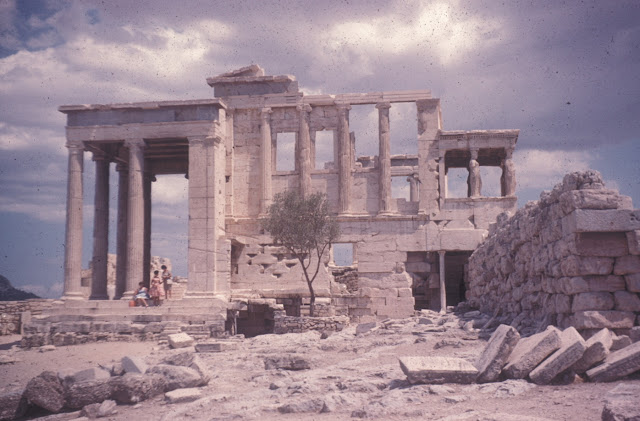












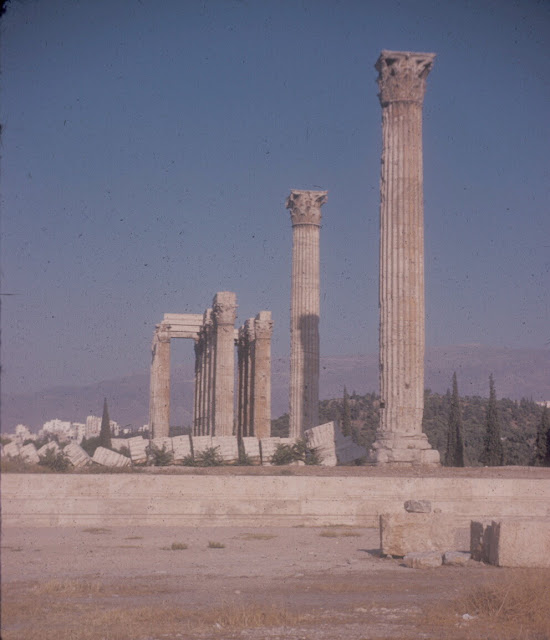








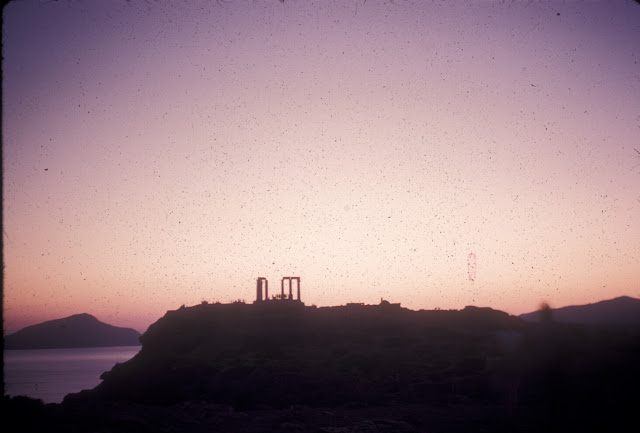








.jpg)





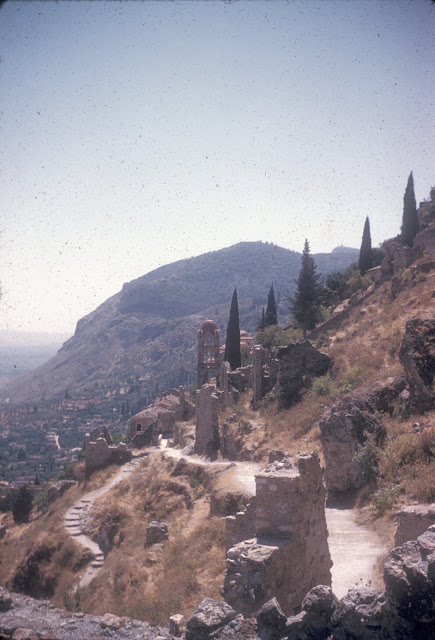





































 T
T



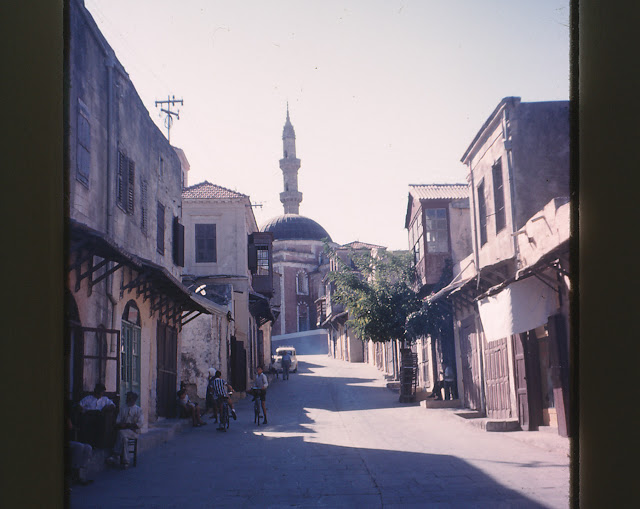

















Dear Derek
ReplyDeleteHow can one contact you?
I need to ask you something
Aris, Greece
enteka11@gmail.com
:)
Sorry for the delay. You can contact me at:
Deletehttps://www.facebook.com/derek.wagon
excellent! very nostalgic....
ReplyDeletehttp://www.chryssiesgreece.com/
derek, i just saw all this beauty through a greek website (http://www.lifo.gr/team/lola/56298) and i was charmed with the pictures, the writing.. I hope you will come back ^_^
ReplyDeleteKisses from Trikala - Greece!
Happy holidays!
This is priceless.
ReplyDeleteThank you, dear Derek, for having the generosity to share this historical material with us.
You are always welcomed in Greece. Your invitation is extended without saying.